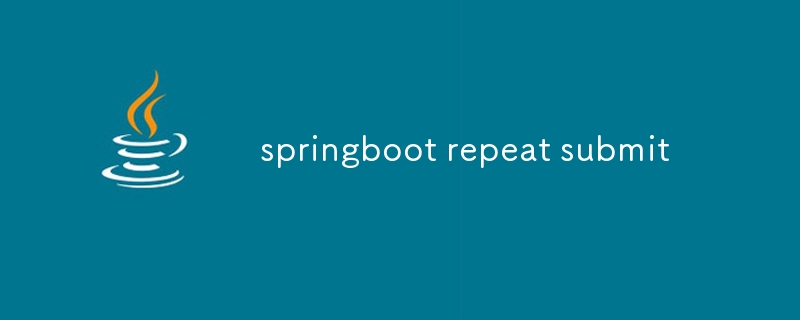Springboot wiederholen
This article discusses various approaches for preventing repeat form submissions in Springboot applications. It explores adding CSRF tokens, using the @ValidateOnSubmit annotation, generating unique request identifiers, implementing rate limiters, an

Springboot Repeat Submit
1. How to Prevent Repeat Submissions with Springboot?
Springboot provides several approaches to prevent repeat submissions:
- Adding a CSRF Token: Cross-Site Request Forgery (CSRF) tokens are unique per session and prevent unauthorized submissions.
- Using the @ValidateOnSubmit Annotation: This checks for duplicate requests based on a form's input parameters.
- Generating Unique Request Identifiers: A GUID or timestamp can be used to prevent resubmitting the same request.
- Implementing a Rate Limiter: Limiting the rate of requests can discourage malicious attempts to repeat submissions.
2. Best Practices for Handling Repeat Submissions in Springboot Applications
- Implement multiple prevention mechanisms to enhance security.
- Use CSRF tokens as the primary defense against cross-site attacks.
- Configure appropriate rate limits to prevent excessive requests.
- Log and track all submission attempts for auditing purposes.
- Consider using a third-party library specifically designed for handling repeat submissions.
3. Is There a Springboot Annotation or Feature to Automatically Handle Repeat Submissions?
Yes, Spring Security provides the @RepeatedSubmit annotation that helps prevent double form submissions by verifying that a unique token is included in the request.
Here's an example:
@PostMapping("/")
@RepeatedSubmit(value = true)
public String handleSubmit() {
// Handle the form submission
return "success";
}Das obige ist der detaillierte Inhalt vonSpringboot wiederholen. Für weitere Informationen folgen Sie bitte anderen verwandten Artikeln auf der PHP chinesischen Website!

Heiße KI -Werkzeuge

Undresser.AI Undress
KI-gestützte App zum Erstellen realistischer Aktfotos

AI Clothes Remover
Online-KI-Tool zum Entfernen von Kleidung aus Fotos.

Undress AI Tool
Ausziehbilder kostenlos

Clothoff.io
KI-Kleiderentferner

Video Face Swap
Tauschen Sie Gesichter in jedem Video mühelos mit unserem völlig kostenlosen KI-Gesichtstausch-Tool aus!

Heißer Artikel

Heiße Werkzeuge

Notepad++7.3.1
Einfach zu bedienender und kostenloser Code-Editor

SublimeText3 chinesische Version
Chinesische Version, sehr einfach zu bedienen

Senden Sie Studio 13.0.1
Leistungsstarke integrierte PHP-Entwicklungsumgebung

Dreamweaver CS6
Visuelle Webentwicklungstools

SublimeText3 Mac-Version
Codebearbeitungssoftware auf Gottesniveau (SublimeText3)

Heiße Themen
 1676
1676
 14
14
 1429
1429
 52
52
 1333
1333
 25
25
 1278
1278
 29
29
 1257
1257
 24
24
 Verursacht die Sicherheitssoftware des Unternehmens, die die Anwendung nicht ausführt? Wie kann man es beheben und es lösen?
Apr 19, 2025 pm 04:51 PM
Verursacht die Sicherheitssoftware des Unternehmens, die die Anwendung nicht ausführt? Wie kann man es beheben und es lösen?
Apr 19, 2025 pm 04:51 PM
Fehlerbehebung und Lösungen für die Sicherheitssoftware des Unternehmens, die dazu führt, dass einige Anwendungen nicht ordnungsgemäß funktionieren. Viele Unternehmen werden Sicherheitssoftware bereitstellen, um die interne Netzwerksicherheit zu gewährleisten. ...
 Wie konvertiere ich Namen in Zahlen, um die Sortierung zu implementieren und die Konsistenz in Gruppen aufrechtzuerhalten?
Apr 19, 2025 pm 11:30 PM
Wie konvertiere ich Namen in Zahlen, um die Sortierung zu implementieren und die Konsistenz in Gruppen aufrechtzuerhalten?
Apr 19, 2025 pm 11:30 PM
Lösungen zum Umwandeln von Namen in Zahlen zur Implementierung der Sortierung in vielen Anwendungsszenarien müssen Benutzer möglicherweise in Gruppen sortieren, insbesondere in einem ...
 Wie vereinfachte ich Probleme mit der Feldzuordnung im Systemdocking mithilfe des Mapstruct?
Apr 19, 2025 pm 06:21 PM
Wie vereinfachte ich Probleme mit der Feldzuordnung im Systemdocking mithilfe des Mapstruct?
Apr 19, 2025 pm 06:21 PM
Die Verarbeitung von Feldzuordnungen im Systemdocken stößt häufig auf ein schwieriges Problem bei der Durchführung von Systemdocken: So kartieren Sie die Schnittstellenfelder des Systems und ...
 Wie kann ich elegante Entitätsklassenvariablennamen erhalten, um Datenbankabfragebedingungen zu erstellen?
Apr 19, 2025 pm 11:42 PM
Wie kann ich elegante Entitätsklassenvariablennamen erhalten, um Datenbankabfragebedingungen zu erstellen?
Apr 19, 2025 pm 11:42 PM
Bei Verwendung von MyBatis-Plus oder anderen ORM-Frameworks für Datenbankvorgänge müssen häufig Abfragebedingungen basierend auf dem Attributnamen der Entitätsklasse erstellt werden. Wenn Sie jedes Mal manuell ...
 Wie identifiziert Intellij IDEA die Portnummer eines Spring -Boot -Projekts, ohne ein Protokoll auszugeben?
Apr 19, 2025 pm 11:45 PM
Wie identifiziert Intellij IDEA die Portnummer eines Spring -Boot -Projekts, ohne ein Protokoll auszugeben?
Apr 19, 2025 pm 11:45 PM
Beginnen Sie den Frühling mit der Intellijideaultimate -Version ...
 Wie kann ich Java -Objekte sicher in Arrays umwandeln?
Apr 19, 2025 pm 11:33 PM
Wie kann ich Java -Objekte sicher in Arrays umwandeln?
Apr 19, 2025 pm 11:33 PM
Konvertierung von Java-Objekten und -Arrays: Eingehende Diskussion der Risiken und korrekten Methoden zur Konvertierung des Guss-Typs Viele Java-Anfänger werden auf die Umwandlung eines Objekts in ein Array stoßen ...
 E-Commerce-Plattform SKU und SPU-Datenbankdesign: Wie berücksichtigen Sie sowohl benutzerdefinierte Attribute als auch Attributloses Produkte?
Apr 19, 2025 pm 11:27 PM
E-Commerce-Plattform SKU und SPU-Datenbankdesign: Wie berücksichtigen Sie sowohl benutzerdefinierte Attribute als auch Attributloses Produkte?
Apr 19, 2025 pm 11:27 PM
Detaillierte Erläuterung des Designs von SKU- und SPU-Tabellen auf E-Commerce-Plattformen In diesem Artikel werden die Datenbankdesignprobleme von SKU und SPU in E-Commerce-Plattformen erörtert, insbesondere wie man mit benutzerdefinierten Verkäufen umgeht ...
 Wie verwendet ich die Redis -Cache -Lösung, um die Anforderungen der Produktranking -Liste effizient zu erkennen?
Apr 19, 2025 pm 11:36 PM
Wie verwendet ich die Redis -Cache -Lösung, um die Anforderungen der Produktranking -Liste effizient zu erkennen?
Apr 19, 2025 pm 11:36 PM
Wie erkennt die Redis -Caching -Lösung die Anforderungen der Produktranking -Liste? Während des Entwicklungsprozesses müssen wir uns häufig mit den Anforderungen der Ranglisten befassen, z. B. das Anzeigen eines ...




